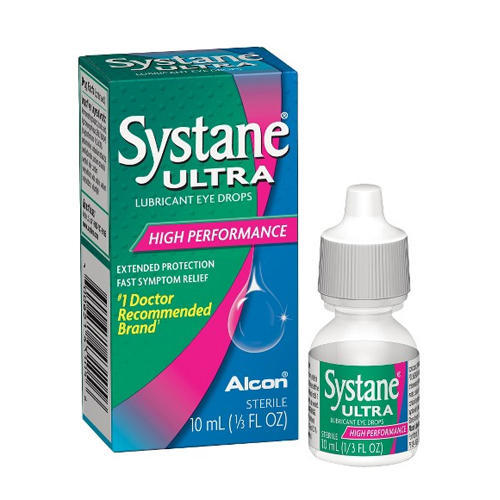The drops are used to treat all kinds of eye problems such as eye discomfort, itchiness, irritation, dryness in the eye, allergy or more serious problems, such as conjunctivitis, inflammation or bacterial infections, for example. This is because they contain substances that improve the lubrication of the eyes, reduce inflation or allergy, or help to eliminate bacteria.
The eye drops are sterile liquid pharmaceutical forms, which must be applied in the eye, in drops, and the number of drops to use must be indicated by the doctor individually.
The type of eye drops to be used depends on the problem to be treated and should only be used under the indication of the ophthalmologist, as although it is a liquid for topical use, it is a medicine and, even if it relieves the discomfort, it may not be treating the disease, it can only mask the symptoms.
The main types of eye drops that are indicated by the doctor are:
1. Lubricating eye drops
Lubricating eye drops, also known as artificial tears, contain substances such as carboxymethylcellulose, carmellose sodium or hypromellose, for example, which help to clean the eyes and keep them properly moist.
These drops are usually indicated to treat dry eye syndrome, burning, irritation or itching caused by dust, smoke, pollutants, chemicals, ultraviolet rays, dry or excessive heat, air conditioning, wind, cosmetics or excessive use of the computer, cell phone or television. They can also be used by people who wear contact lenses and experience a lot of dry eyes.
Some examples of eye drops that can be used to lubricate the eyes are Systane, Lacril, Trisorb, Lacrima Plus, Lacribell, Artelac or Lacrifilm, which can be purchased at pharmacies without the need for a prescription. However, it is recommended to consult an ophthalmologist to assess the cause of dryness in the eye and indicate the most appropriate lubricating eye drops.
2. Antibiotic eye drops
Antibiotic drops are used to treat eye infections caused by bacteria, called bacterial conjunctivitis. Generally, most drops, in addition to antibiotics such as neomycin sulfate, polymyxin B sulfate, or moxifloxacin, are combined with corticosteroid anti-inflammatory drugs such as dexamethasone to help reduce inflammation, tearing, and discomfort caused by the infection.
Some examples of antibiotic eye drops are Maxitrol, Zymar, Vigadexa or Cilodex, which are sold in pharmacies or drugstores with a prescription.
3. Anti-inflammatory eye drops
Anti-inflammatory eye drops contain substances that reduce eye inflammation, such as tromethamine ketorolac, sodium diclofenac or nepafenac, for example, and are especially indicated in cases of recovery from eye surgery or in the treatment of diseases such as chronic viral conjunctivitis or keratitis, an inflammation that arises in the cornea.
Some examples of eye drops with anti-inflammatory action, indicated for the prevention and treatment of pain and inflammation are Acular LS, Maxilerg, Nevanac or Voltaren DU, for example.
4. Anti-allergic eye drops
Antiallergic eye drops contain antihistamine substances, such as epinastine hydrochloride, ketotifen fumarate, alcaftadine or fluormetholone acetate, for example, which help relieve symptoms of allergic conjunctivitis, such as redness, itching, irritation, tearing or swelling in the eyes. Know how to recognize the symptoms of allergic conjunctivitis.
Some examples of anti-allergic eye drops are Relestat, Octifen, Lastacaft or Florate, sold in pharmacies or drugstores with a prescription.
5. Anesthetic Drops
Anesthetic drops alleviate eye pain and sensitivity, which allows for ophthalmic medical procedures to be performed. However, this type of eye drops can be dangerous, as they remove pain and sensitivity, which can make the person hurt, as scratching the eye can cause damage to the cornea due to the lack of sensitivity.
Some examples of anesthetic drops are Anestalcon and Oxinest, which can be used by the doctor, in the hospital or in the office, for diagnostic tests, such as measuring eye pressure, shaving the eye or removing foreign bodies, for example.
6. Decongestant drops
This type of eye drops, also known as vasoconstrictors, decongest and lubricate the eyes, being especially indicated to help relieve mild irritation or redness in the eyes caused by colds, rhinitis, foreign bodies, dust, smoke, hard contact lenses, sun or water from the pool and the sea, for example.
Examples of eye drops with vasoconstrictor action are Freshclear, Moura Eye Drops, Lerin or Teuto Eye Drops, for example, and should be used with an ophthalmologist indication, as they are contraindicated for people with glaucoma or who use monoamine oxidase inhibitors (MAOI) medications. as isocarboxazide, phenelzine or tranylcypromine, for example.
7. Eye drops for glaucoma
Glaucoma drops are designed to reduce blood pressure in the eyes, and should be used daily, with medical indication according to the type of glaucoma, to control the disease and prevent blindness.
Some examples of drops used to treat glaucoma are Alphagan, Combigan, Timoptol, Lumigan, Xalatan, Ocupress or Cosopt, for example. See other drops used to treat glaucoma and the most common side effects.
How to use the drops correctly
When using any type of eye drops, there are some precautions to be taken, such as:
- Avoid touching the tip of the bottle to your eyes, fingers or any other surface;
- Immediately close the bottle of eye drops, as soon as the application is finished;
- Always use the number of drops indicated by the doctor, to avoid overdose;
- Wait at least 5 minutes between applications, if it is necessary to use more than one eye drop;
- Remove contact lenses before applying eye drops and wait 15 minutes after application before putting them back on.
These precautions are very important as they guarantee the correct use of the drops, preventing the contamination of the bottle and the medicine.
During the application, the ideal is to lie down and drop the drops in the lower part of the eye, more specifically in the red pouch that forms when pulling the lower eyelid downwards. Then, close the eye and press the corner close to the nose to help with local absorption of the drug.
